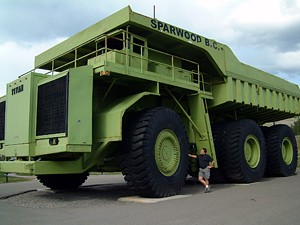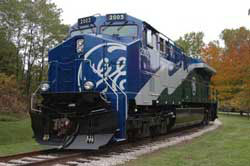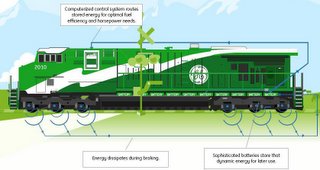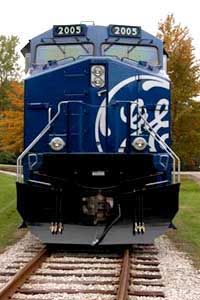Pardon Me, Boys - Is That The Chattanooga Series Hybrid Propulsion Unit?
OK, it's time for an educational pop quiz! No, you weren't done with these in college, so get ready.
Quick: In terms of size, what upcoming hybrid vehicle would be deemed the largest?

Oh, don't worry. It's not that hard of a quiz...
At this stage, a rational mind would lay the compact Toyota Prius and the shrinky-dink Honda Insight to rest.
Uhh...Chevrolet Tahoe?
While I don't question the joys of negotiating crowded shopping-mall parking lots in such a vehicle, I consider the lack of needing steel berms for steering aids a plus.
Thus, the answer to the question is most likely the up-and-coming GE Hybrid Diesel-Electric Locomotive.

Those without much prior knowledge of trainsets will possibly marvel that something this large could be a hybrid, a term spun so often by 'green' auto manufacturers to represent something that's ecologically beneficial, as well as the latest and greatest powertrain innovation.

That's not necessarily so. Ferdinand Porsche, godfather of the VW Beetle and the brand bearing his name, first built such a car in the late 1800s. Hybrid locomotives have been around since 1913, when GE first implemented diesel-electric systems in their products. And in a twist that's very much ironic, many of those gargantuan dump trucks utilized in strip mining, that detrimental extrapolation of natural resources, are diesel-electric hybrids as well.
In these cases, the powertrain is a simple Series Hybrid layout. In this configuration, the internal combustion motor drives a generator, which is wired to large electrical motors at the drive wheels. As the motor generates electricity, it's sent to the wheel motors, in turn allowing the vehicle to move.

So then, what's so new about this? What's been missing all these years is a crucial factor - energy storage. These locomotives have never carried any form of electrical storage devices, whether it be battery cells, supercapacitors, etc. While this isn't critical to operating a locomotive, it's not efficient.
There's quite a bit of kinetic engery within a train, particuarly one that's both long and loaded - say, 240 tons, on average. Under even the lightest of braking conditions, a tremendous amount of motion is transmitted to energy. GE estimates that the amount of energy emitted by a locomotive's stoppage over the course of a year could potentially power 160 households annually.
That's a vast amount of untapped power.

So, GE offers to solve this with their product with a rather simple idea: regenerative braking. This system, seen most often on electric or hybrid passenger cars, converts the energy released through braking back into electricity, and stores it on board in battery cells. GE's made no announcement regarding the type and size of their battery packs, aside from the fact that they'll be lead free and rechargable - two blatantly obvious facts.
Will this be effective? According to GE's press rhetoric (re: spin), it should be. Estimates show that fuel consumption could be theoretically cut up to 15%, and particulate emissions as much as 50% with such a system. But, for a company that's proud of its "ecomagination", is this enough?
GE could theoretically - and, quite easily - do more. One of the most inefficent states of current diesel-electric locomotives is when it's forced to do nothing more than sit still with it's engine on. This happens quite frequently on railroads, whether the train's at a station, in a switchyard, on a siding, or what have you. The end result is the locomotive's sitting at a stop, but it's powertrain is still working to produce energy to move it.
A simple solution to this would be to allow the engine/generator to charge the batteries while at a stand still. In fact, with this aspect being so prevalent in production hybrid vehicles, it's a wonder that an energy company such as GE didn't think of it as well.
Then again, there's still time. No new specifications on the project have broken since the last year, and it very well may be incorporated into production variants. It'd be nothing short of plain stupid to take a half-step forward in the realm of energy efficency.

Take it from GM, GE - don't go offering 'mild hybrids' when you could do much more.


0 Comments:
Post a Comment
<< Home